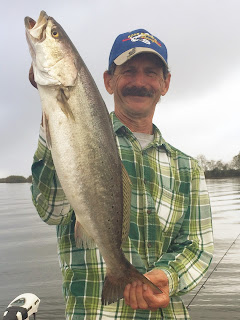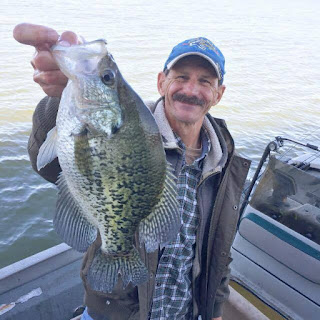Top to Bottom for Cold water Specs
Maybe this blog should read, from "bottom to top." Cold water temps can make speckled trout fishing tough at times. This last cold snap has been no different. While red fishing was fantastic, the cold water had slowed the trout bite, or had it? While it is certainly true when water temps are in the forties, trout are difficult to catch. There are always exceptions to this rule. Deeper waters may produce trout even with cold water temperatures. When the waters warm to the fifties, it becomes much easier to catch wintertime fish.
The one thing to know about cold water trout fishing is to figure out what presentation is most effective. Today was a perfect example of what to do and what not to do. Some folks went home with very few fish, while others had limits. So what made the difference from a slow bite to fast and furious? It was simply presentation. Trout fishing can be predictable if you know the pattern. If it has been a cold night, it may be better to either find deeper water or just slow your retrieve down. Slow may be an understatment. Sometimes just letting the bait fall to the bottom and lifting the rod tip is most effective. Sometimes just a very slow and steady retrieve works best. The key is to go slow. As the air temps rise during the day, your presentation may need to change. If what was working has stopped, it may be just a matter of adjusting to the change in water temperauires. What may have started as a lethargic, slow bite, may become a more aggressive one. In this case a faster retrieve or changing lures may be the most productive. Besides presentation, lure selection can be important. While there will never be a consensus on what works best. After all, you can talk to 10 different fisherman who had limits and they may all be using a different lure. So where does the novice begin to choose the right lure. The most common method for winter time trout is casting a 1/8th ounce jig head with a tout or one of the many swim type baits available. It is best not to over think your decision. Usually any color and chartreuse works. The most common color is purple/chartruse, green/brown/chartruse, or just chartreuse. As the waters warm during the day, many of the suspending baits or jerk baits work well. Mirror lure, Rapala, and Yo-zuri are just a few to choose from. Some of these baits may be pricey, but some stores have their own brand of the same style of baits that are more affordable. Suspending baits are easy to cast and simple to work. It is a basic, cast, twitch twice and stop retrieve. These baits usually run 1-2 feet under the surface and when trout are active are real effective. The other method that is not used much is letting these suspending baits drag behind the boat. Although this method only works if the wind is strong enough to move the boat fast enough to keep the bait off the bottom. On windy days, it is a great method to try. The last method that many over look on a cold day is top water. Top water fishing is always feniky, and not for all, but when it is on, can be the most exciting way to catch fish. Today was the perfect day for trout fishing. The morning started cold, water temps in upper forties and as the sun heated the day, rose to the mid fifties. That change in the water temps changed the fishing from slow rolling a jig off the bottom, to killing them on a suspending bait, to hooking up on topwater. As the winter progresses, there will be more days like today. Adapting to these changes will increase your chances of catching limits of beautiful trout. Good luck fishing. Hope to see ya on the water.





Comments
Post a Comment